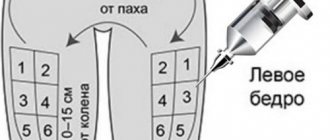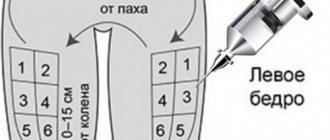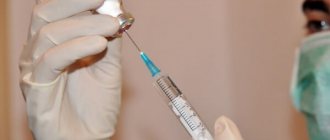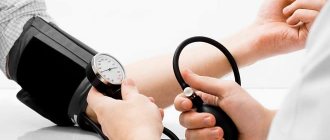To inject yourself into the thigh muscle tissue, you must have basic skills in using a syringe, needle and injection solution. It is recommended to resort to these therapeutic actions only in extreme cases, when there are no close people or medical workers nearby who can administer the drug intramuscularly.
Independent use of injection solutions requires compliance with safety rules, as well as a number of preparatory procedures that minimize the risk of complications.
Can I inject myself?
Injections into the muscle tissue of the outer thigh can be performed independently without the help of strangers. In order to administer the drug by injection to yourself, you should study in detail the provisions of the instructions that regulate the conduct of this kind of therapeutic measures.
Only if you have basic knowledge about the anatomical structure of the hip, the location of the lateral and deltoid muscles, and the possible risk of developing unwanted complications, can you begin independent treatment.
If you have the slightest doubt, a feeling of fear or an attack of panic that appears at the sight of a medical needle, it is recommended to refuse to inject the medication without the help of strangers.
Correct needle insertion site
The insertion of a syringe needle for the purpose of a therapeutic procedure can be carried out into the muscles of the buttock or the outer side of the thigh. These are the main areas of the human body that are best suited for intramuscular injections. In some cases, shoulder tissue may be used.
Where to give injections in the thigh
If there is a need to inject into the outer side of the thigh, then it is necessary to use that part of the lower limb that is located at a distance of 20-25 cm below the hip joint. This area of the leg has sufficient muscle mass density, and the injection of a medicinal solution will be as convenient and safe as possible.
Scheme for determining the injection site
First of all, we need to decide where we will inject: into the thigh or gluteal muscle. Each method has its own advantages and disadvantages. Therefore, you should choose based on your own preferences.
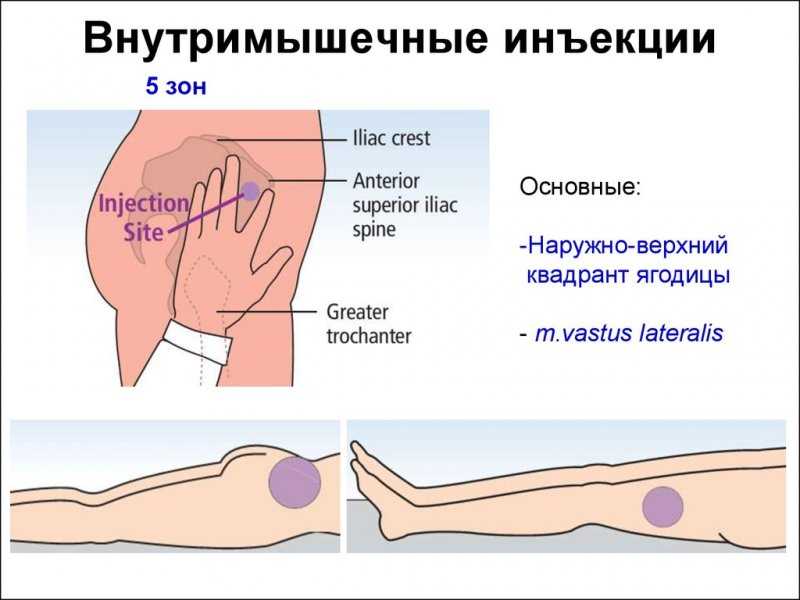
To choose the right place for injection in the buttock, you need to mentally divide it crosswise into four parts. The injection area is in the upper outer corners.
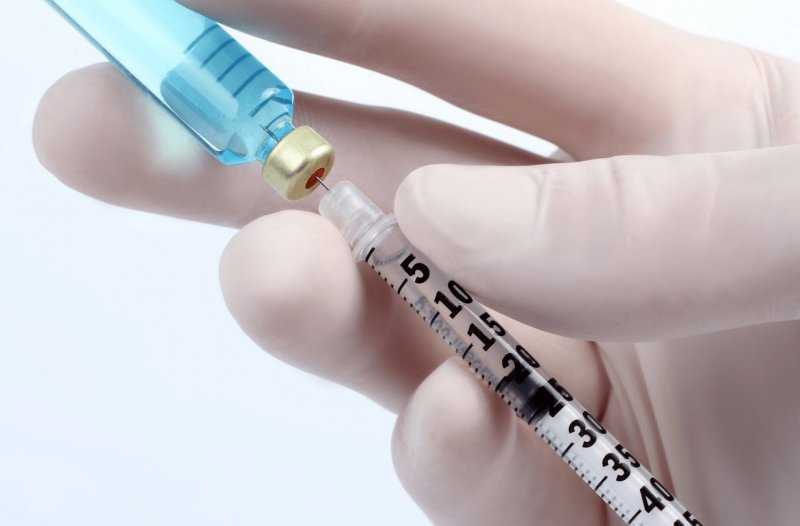
To give an injection into the femoral muscle, you need to mentally divide the anterior-outer side of the thigh into three equal parts. The needle should be inserted into the middle one.
What is required for the procedure?
It is necessary to give injections in the thigh to yourself only after carrying out high-quality hygiene of the surface of the hands.
To carry out this therapeutic procedure, you will need to have the following items available:
- a sterile disposable syringe with a capacity of 2, 5, 10 ml, complete with a standard medical needle intended for intramuscular administration;
- a bottle or ampoule with a liquid medicinal solution that is indicated for use for therapeutic purposes;
- detailed instructions for using the drug to be injected into the outer thigh (before giving the injection, you must re-read the section on the dosage regimen);
- a pack of sterile medical cotton wool or pre-prepared napkins, tampons, which are used for antiseptic treatment of the skin surface of the thigh;
- ethyl alcohol 96% concentration, intended for disinfection of the tissue area into which the medicinal solution will be injected;
- a pair of medical gloves, the packaging of which is opened immediately at the time of therapeutic manipulations.
A medical needle for performing an intramuscular injection must have a length of at least 3 cm. This will minimize the appearance of unpleasant sensations after its introduction into the muscle tissue, and will also ensure the deepest possible application of the drug.
The components of the injection solution will act much faster, which will significantly increase the likelihood of a positive therapeutic effect.
Using a syringe with a needle that is too short can lead to the injection of an injection solution into the area of subcutaneous fatty tissue, which will subsequently cause local tissue inflammation, as well as the development of other undesirable complications.
Preparation for the procedure
Injections in the thigh should be given to yourself only after high-quality preparatory measures have been completed. This is a prerequisite for successful treatment without the help of medical personnel.

Preparation for self-administration of an injectable drug into the outer side of the thigh muscles involves the following steps:
- You need to take a bar of laundry soap and thoroughly wash your hands using warm water. Dry your skin with a clean and dry towel.
- Then you will need to open the package of medical gloves and put them on your hands, ensuring maximum sterility.
- The ampoule with the drug is shaken to ensure uniform mixing of all components, and then its surface is wiped with cotton wool, which has been previously moistened in 96% concentration of ethyl alcohol. These actions are aimed at disinfecting the bottle of medication.
- The tip of the ampoule with the injection solution must be carefully filed with an abrasive element, which should come with the drug, and then its glass top must be broken off.
- Open the package with a disposable sterile syringe.
- Place a medical needle on top of the syringe, remove the protective cap, and then insert it into the glass ampoule with the injection solution.
- Pull the plunger of the syringe so that a sufficient amount of liquid medication enters its cavity. In this case, it is necessary to remember the dosage regimen of the drug, avoiding the use of too large doses.
- Squeeze out the remaining air bubbles from the syringe that got into it during filling with the injection solution. These actions stop immediately as soon as the first drops of medication begin to flow from the needle hole.
At this stage, the specified organizational measures aimed at preparing for self-administration of the drug into the muscles of the outer thigh are considered completed.
To maintain maximum sterility, the injection is recommended to be given immediately. The disposable syringe is disposed of immediately after injecting the solution into the tissue of the lateral or deltoid muscle.
Getting ready for manipulation
Having prepared everything necessary for the procedure, you can proceed to its actual implementation.
To make this not-so-pleasant process as calm and painless as possible for your baby, you should adhere to some simple but mandatory rules:
Before you begin any manipulations, you need to wash your hands well with soap, or better yet, further disinfect them with medical alcohol or alcohol wipes; neither the syringe nor the needle needs to be opened in advance - it is better to print the kit immediately before the injection is given; since it is still unclear to the baby what the meaning and purpose of your preparations are, try to do everything quickly, but carefully and calmly, since chaotic movements or panic can frighten him and prepare him in advance for an unpleasant procedure; Taking the ampoule with the medicine, warm it a little in your palm so that the injection is not cold; if there are no special instructions from the doctor, then the injection should be done in the butt, especially since if you are not a professional when it comes to injections, then after injections in the arm or thigh some negative consequences may occur; before giving the injection, it is better to stretch the muscles of the baby’s buttocks with light massage movements that do not cause tension, while your hands should be warm; the procedure should be carried out in a place where both you and the child will be comfortable - keep in mind that the baby should lie on his tummy during the injection, and also make sure that there is sufficiently bright lighting there; Before opening the medicine, check its expiration date again and be sure to check the dosage and name of the medicine with the prescription; The ampoule should also be wiped with sterile gauze or cotton wool soaked in medical alcohol; do not break off, do not beat off and, of course, do not bite off the tip of the ampoule - to open it correctly, use a special file, otherwise there is a risk that small fragments will get inside when opening; using this device, you need to make a small incision / notch on the ampoule along the line of the intended break - that is, just run a nail file along it with pressure several times, but before that, shake the ampoule a little and tap on its tip with your fingernail so that the medicine flows down; if you are afraid of cutting yourself, wrap the ampoule with a napkin and press its tip away from you; Having opened the medicine, set it aside for a couple of seconds and use the syringe; unpack it from the piston side and connect it to the needle directly inside the package without removing the protective cap from it; It’s good if the kit contains two needles - the one that is long and coarser, you will pierce the stopper of the bottle with the drug or you can lower it into the very depths of the ampoule, and the other - small and thin - then you will give the injection, the kit should come with them and sterile tweezers, with which you can change the first needle for the second; so, remove the cap from the needle and lower the piston of the syringe with the needle all the way into the ampoule or bottle of medicine, so that no air enters the syringe; slowly and carefully draw in the liquid, pulling the piston towards you; it is better to take a little more medicine than needed, since then you will need to release excess air from the syringe - to do this, make a few clicks on the syringe so that the air bubbles rise up, and, turning it over vertically, gradually press the plunger until a drop of liquid will not appear at the tip of the needle; After this, you can close the needle with a cap.
If the medicine prescribed for your child is not sold in ampoules with liquid, but in bottles with dry powder, then you will need to do the following:
- all manipulations with preparing the syringe will be the same;
- Taking a bottle of powder, also wipe it with sterile gauze or cotton wool with ethyl alcohol and open the metal cap;
- then wipe the rubber cap that was under the metal one, pierce it with a needle and introduce the solvent;
- shake the bottle for a while until the powder is completely dissolved and no grains or lumps remain;
- turn the bottle over with the cap down and draw the solution into the syringe;
- release excess air and replace the needle with a cap.
Pediatricians advise carrying out all preparations out of sight of the child, so as not to once again frighten him with incomprehensible medical manipulations. It is better to prepare in another room or in the kitchen, and then come to the baby, who may be distracted by another family member at this time.
Basic safety rules when injecting yourself in the thigh
Injections in the thigh must be given to yourself with extreme caution so as not to damage large blood vessels and peripheral nerves.
A prerequisite for self-therapy with injection administration of drugs is compliance with the following safety rules:
- it is strictly forbidden to reuse a disposable syringe and needle, since such actions are fraught with infection of the tissues in the area of the injection;

- if it is necessary to carry out long-term drug therapy using intramuscular injections, it is necessary to alternate the left and right sides of the thighs in order to eliminate the factor of the formation of extensive hematomas;
- You should not inject into the same point of the thigh tissue, as this will lead to the appearance of symptoms of acute pain and will also cause the development of inflammatory processes;
- use imported syringes, as they are distinguished by sharper and thinner needles that do not cause severe pain in the area of their insertion, having minimal trauma to epithelial and muscle tissues;
- before intramuscular administration of the drug, it is always necessary to perform an antiseptic treatment of the skin surface to avoid complications;
- If minimal signs of an inflammatory process or the onset of subcutaneous bleeding or the formation of an extensive hematoma appear, you must immediately seek medical help.
It is important to remember that at the moment of self-injection into the outer thigh, the lower limb should be relaxed. For this purpose, the leg is placed on a flat surface, since excessive tension can provoke involuntary contraction of the muscle with damage to its tissue structure. A similar reaction occurs immediately at the moment of needle insertion.
How to give an injection correctly?
The most common methods of administering drug therapy in the form of injection solutions are injections into the deltoid, gluteal and lateralis muscles.
During a long course of treatment, the use of these areas of the body can be alternated to avoid the development of an inflammatory process in the tissues of the muscular system. At the same time, it is always necessary to follow the rules for the safe administration of medications that are available in the form of medicinal solutions.
Injection into the deltoid muscle
The deltoid muscle covers the entire front and side of the shoulder and is also distinguished by its dense tissue structure.
In order to inject yourself into this area of the body, you must adhere to the following algorithm of actions:
- Carry out all organizational activities dedicated to preparing for the injection of medication.
- Soak a piece of sterile cotton wool or a previously prepared swab in 96% concentration of ethyl alcohol.
- Perform an antiseptic treatment of the skin surface of the shoulder, wiping it thoroughly.
- Visually divide the deltoid muscle into 4 even squares.
- Bring the syringe with the exposed needle to the skin surface of the shoulder.
- Using a smooth and precise movement, insert the medical needle of the syringe into the upper right segment of the deltoid muscle to a depth of 2 cm.
- Slowly administer the injection solution contained in the cavity of the disposable syringe. Depending on the type of medication, a faster or slower injection of the medication may be required. In this case, you must carefully read the instructions for use of the drug.
- After administering the injection solution, it is necessary to slowly remove the syringe needle from the deltoid muscle tissue.
- Immediately cover the injection area with a clean piece of cotton wool, which has been previously moistened in 96% concentration of ethyl alcohol.
- Hold the cotton wool for the next 10 minutes, and then dispose of it in the prescribed manner. If signs of bleeding of the tissues located at the injection site appear, it is necessary to re-moisten the cotton wool in ethyl alcohol and hold it on the surface of the wound for another 10-15 minutes.
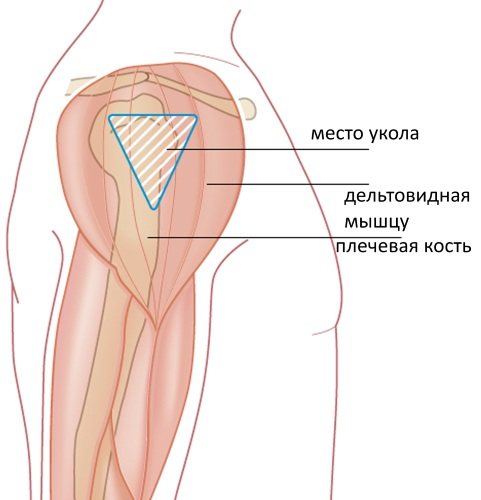
After injection of the drug into the deltoid muscle, mild discomfort may persist in the tissues of the shoulder. The appearance of more severe symptoms in the form of acute pain that does not stop for several days requires additional examination by a general practitioner or surgeon.
During the injection, the hand into which the drug is injected should be in the most relaxed state. This will reduce the severity of pain.
Injection into the lateralis muscle
It is not difficult to give injections in the thigh to yourself, but performing this type of procedure requires composure, a steady hand and maximum concentration. In order for the injection of the drug to be carried out technically correctly, the following instructions must be observed:
- Take a piece of sterile cotton wool, soak it in 96% concentration of ethyl alcohol, and then perform an antiseptic treatment on the outer surface of the thigh.
- Visually divide the lateralis muscle into 4 identical segments located 20 cm below the hip joint.
- Place the lower limb on a flat surface, completely relax its muscles, and place a cushion made of a towel or a piece of dense fabric under the knee joint. This will avoid reflex muscle contraction, which can occur immediately at the time of the injection.
- Insert a medical needle from a disposable syringe into the lower right segment of the lateral muscle, immersing it into the body to a depth of 2 cm.
- Slowly and without sudden movements, administer the injection solution until it is completely injected into the tissues of the lower limb.
- Smoothly remove the needle from the outer side of the thigh, and wipe the injection site with sterile cotton wool soaked in a 96% alcohol solution. Then you should press the cotton wool against the wound to avoid increased bleeding of the damaged area of the body.
- Hold the cotton wool for the next 10-15 minutes.

During the injection, it is necessary to keep the syringe as level as possible. The needle should not be directed at an acute angle, as in this case the injection will be too painful and may cause undesirable complications.
After injection of the drug, you should refrain from sudden movements for 20 minutes. The leg should be on a flat surface without being subject to physical stress.
How to learn to give injections yourself at home?
Do not panic under any circumstances, because the entire success of the procedure depends on the accuracy of your actions.
- Visually divide any baby’s buttock into four identical square-shaped sectors, that is, as if drawing a cross in the middle to make four identical squares.
- Your task is to inject into the center of the uppermost square or quarter of the gluteal muscle, since it is there that there are no vascular nerve bundles, which, if you get into them, can provoke bleeding, cause pain, numbness of the limb and other unpleasant consequences.
- Wipe the area where you will inject with a cotton swab soaked in rubbing alcohol.
- Try to secure the child as much as possible so that he does not accidentally jerk during the injection and break the needle. It’s good if someone from your family helps you - while you administer the medicine, the baby needs to be held, distracted, and comforted.
- If you give the baby an injection yourself, you can put him on his tummy on your lap and hold him in place with your other hand.
- After massaging the baby’s buttocks, with your free hand grab the area you will be injecting into - the upper outermost part of the butt, and gather it into a fold.
- Then, with a precise and quick movement, insert the needle two-thirds into this thick fold at a strictly ninety-degree angle.
- Continue to hold the needle perpendicular to the plane of the butt, release the buttock, and fix the syringe in your hand with your index and middle fingers, while keeping your thumb on its piston.
- Slowly press the plunger and inject the medicine.
- Press the area on the butt where the needle was inserted with a cotton swab soaked in alcohol, and with a quick, clear movement, pull out the needle.
- Massage the injection site with a cotton swab a little so that the alcohol can disinfect the wound and the medicine can be absorbed faster.
- Cap the syringe needle and throw away the used syringe.
That's all, the unpleasant procedure is over, but if you do everything correctly, the child should feel virtually no pain.
Learning how to give injections correctly is not at all difficult. In this matter, however, as in any other, practice is needed. You can train on grapes - they have delicate skin and small size.
You can watch special training videos. Including those that teach future doctors. They will help you better understand exactly where and how the injection should be given. With each new injection you will act more confidently and faster. By observing the child's reaction, you will select the optimal rate of drug administration.
Possible complications
Technically incorrect execution of the injection, or failure to comply with the basic rules of preparation for intramuscular injection of an injection solution, can lead to the development of various kinds of negative consequences.
The table below lists the main types of complications that occur in patients who perform self-injections into the outer thigh or deltoid muscle of the body.
| Types of possible complications | Characteristics of the pathological process |
| Hematoma | The formation of a hematoma in the area of injection of the drug occurs due to the fact that when the needle penetrates the muscle tissue, damage to a large vessel occurs. The blood enters the subcutaneous tissue, coagulates and forms a dense lump, which is quite painful to the touch. The lack of treatment for this complication leads to more severe consequences in the form of the development of an acute purulent-inflammatory process. In this case, the help of a surgeon may be required to sanitation the damaged tissue. For faster resorption of the resulting hematoma, regular treatment of the painful area with ointments and gels with angioprotective properties is recommended. |
| Isolation of infiltrate | One of the most common complications that arise after self-performing intramuscular injections is the release of infiltrate, which accumulates in the subcutaneous space and soft tissues. The sacral fluid enters the surface of the epidermis and is distinguished by a rich reddish tint. A similar complication develops after a medicinal solution is injected into the same place for several days in a row without making a sufficient indentation. The release of infiltrate indicates the initial stage of the inflammatory process, which tends to progress. To eliminate this complication, a warm compress is applied to the surface of the outer thigh or deltoid muscle, and a mesh of medicinal iodine solution is also applied. |
| Broken medical needle base | A complication in the form of a broken syringe needle may occur due to a violation of the technical rules for performing the injection. For example, if at the time of the injection the muscle tissue of a person’s lower limb was in a state of tension, or the needle was inserted into the body at an acute angle until the very beginning of its cannula. If such an unusual situation arises, it is necessary to remove the needle fragment using medical tweezers. If the metal part goes too deep into the tissue, then you should use the services of a surgeon. |
| Purulent inflammation | This complication occurs due to the fact that a person who independently performs injections on the outer side of the thigh does not follow the rules of antiseptic skin treatment. During the injection of the drug, infection of soft tissues occurs, which are subsequently affected by bacterial, viral or fungal microorganisms. Purulent inflammation of the injection site is accompanied by the formation of a dense abscess, an increase in general and local body temperature, and the beginning of the process of tissue necrosis. |
| Lump formation | The appearance of lumps in the area where the drug was injected without signs of acute pain is possible if a person independently administered injections, but did not follow safety rules. In conditions of prolonged hypothermia of the body, the solution hardens in the muscle tissues, and their natural trophism is disrupted. Ultimately, compactions form in the lateral or deltoid muscle, the elimination of which requires the use of drugs with absorbable properties or the method of their surgical removal is used. |
| Nerve damage | In order to prevent this complication from occurring, it is necessary to inject directly into the muscle where there is no passage of peripheral nerves. A person who does not have knowledge about the anatomical structure of his body may mistakenly insert a syringe needle next to a nerve. As a result of performing these actions, an attack of acute pain occurs, a reflex contraction of the muscle tissue of the limb occurs, and their edematous state develops. The pain syndrome may persist for a long period of time. |

The occurrence of the above complications can be avoided if injections are performed technically correctly and safety rules are followed.
Where can I inject medications for intramuscular administration?
The area where the injection should be given is determined as follows: sit the person down (or sit down yourself if you are injecting yourself). The lateral part of the thigh, flattened in this pose, will be the desired zone (mentally divide it into three parts - you need the upper one). Remember the location.
We invite you to familiarize yourself with Physical therapy for the lumbar spine
Before inserting a needle, it is necessary to treat the desired area of the body with alcohol.
The patient should take a comfortable position. Give the injection while standing with your leg bent (45 degree angle) or lying on your back (this position is preferable - it is more relaxed). Wipe an area of 10 × 10 cm with alcohol applied to a cotton swab. Then moisten another cotton swab and treat a smaller square of skin (approximately 5 × 5 cm) - it is in this area that you should prick.
Begin to carefully insert the needle into the area of the thigh treated with alcohol - 1-2 cm into the muscle. It is recommended to check whether the needle has entered the lumen of the vessel. To do this, without removing the syringe, pull the plunger towards you a few millimeters (be careful that it does not pop out). If no blood comes into the syringe, then everything is fine.
To make the injection as safe, quick and painless as possible, follow these tips:
- Before injecting, pat the skin a couple of times to get the blood flowing.
- Do not inject in the same place - it is better to alternate thighs.
- People with very thin builds need to gather the skin into a fold and inject into it (to avoid getting into the bone).
- Make sure that the person receiving the injection does not strain the thigh muscles, otherwise the procedure will be uncomfortable.
- It is advisable to use syringes with a dark rubber plunger - the administration of the medicine will be slow and painless.
- The needle should be as thin as possible (for two-cc syringes it is thinner than for five-cc syringes).
Follow all the tips described in the article, and you can easily make an intramuscular injection into the femoral part of the body. There is nothing complicated about injections into the thigh area. With a little practice, you'll be able to administer injections as well as a trained nurse.
So it turns out that in all respects, learning to give injections yourself is the best way out of the situation. You will save both time and money! It's good when someone in the family has this skill. Otherwise, treatment will turn into a very big problem.
How to properly give an intramuscular injection to yourself is a task accessible to every person. You need to overcome slight fear and uncertainty, carefully read the instructions, practice, for example, on a soft pillow, and get down to business. Prepare carefully to avoid causing yourself unnecessary pain.
The medicine is injected intramuscularly only into large muscles - the gluteal muscles, the anterolateral surface of the thigh muscles and the deltoid muscle of the shoulder. More often it is injected into the leg or buttock. Some vaccines are injected into the shoulder muscles, as well as first aid medications (painkillers, anti-shock) in emergency conditions, when there is no time or opportunity to administer the drug differently.
In most cases, they try to inject intramuscularly into the upper-outer part of the buttock, since in this area the muscle tissue is thickest and there is the least danger of touching a large nerve or blood vessel. The gluteal muscles have a well-developed capillary network, so the medicine quickly enters the general bloodstream.
An alternative to the gluteal region for intramuscular injections is the vastus lateralis muscle. Injections in the thigh are used when lumps have formed on both buttocks due to a long course of treatment with intramuscular drugs, or abscesses due to improper administration of the drug into the buttocks.
In this case, the thigh surface is more accessible for insertion. To select the injection site, you need to place your hand on the anterolateral surface of the thigh so that the fingertips touch the knee. The area of the femoral muscle under the palm (closer to the wrist) will be the optimal site for administering the medicine. It is strictly prohibited to stab into the thigh above or below this area, as well as from behind or on the inside of the leg due to the high risk of hitting large vessels and nerves.
When giving an injection to a child or thin adult, to be sure that the needle has hit the muscle, before the injection you need to collect the intended injection area into a large skin-muscular fold and feel the muscle under your fingers.
Why does my leg hurt after an injection and what should I do?
Pain that persists for more than 1 hour after intramuscular injection may be caused by injury to a blood vessel or peripheral nerve. In this case, you need to seek medical help from a surgeon.
To give yourself an intramuscular injection into the outer thigh or deltoid muscle of the shoulder girdle, you must have basic knowledge of the anatomical structure of the human body. In this case, you should follow the rules of the instructions for inserting a medical syringe needle into soft tissues, and carefully carry out all stages of preparation for this therapeutic procedure.
Failure to comply with antiseptic body treatment measures, reuse of disposable syringes, prolonged hypothermia of the body can provoke the development of complications in the form of local inflammation, the formation of a purulent abscess, and multiple lumps.
